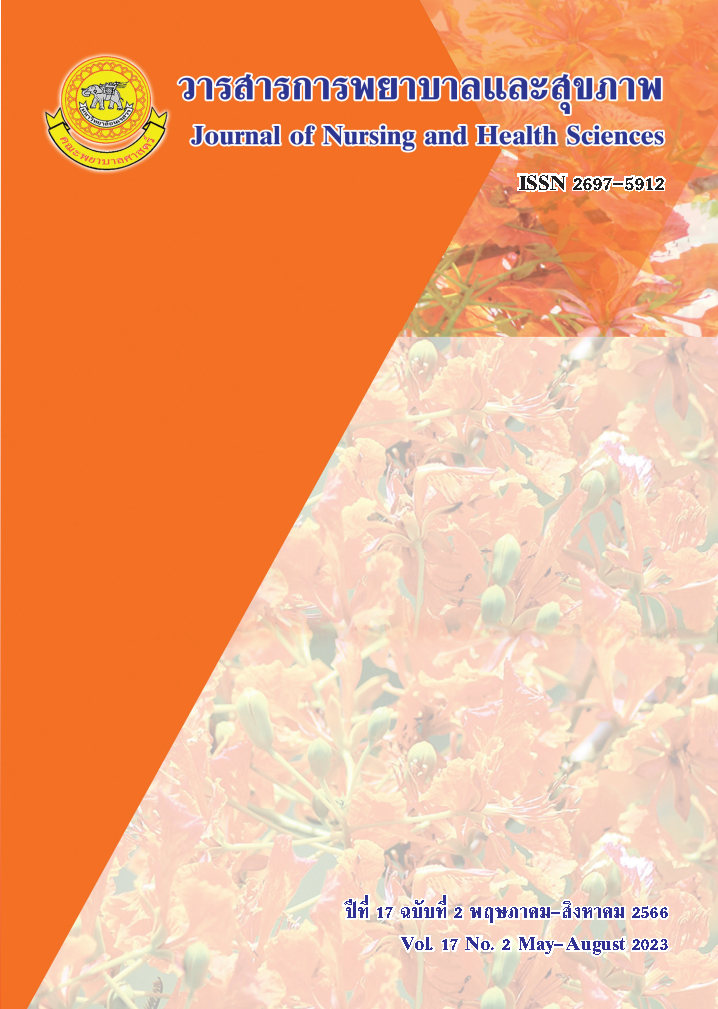The Effects of Learner Development Based on VARK Learning Approach on Creativity and Achievement of Nursing Students
Main Article Content
Abstract
This research was Quasi-Experiment to study the effect of teaching management according to
learning style for the ability to develop creative thinking and academic achievement of nursing students. The
objectives of this study were 1) to study the VARK learning characteristics of first year nursing students, 2)
to compare the scores of creative before and after the development of learners by creating a set of knowledge
linking games and mind mapping of anatomy. and physiology 3) to compare the mean achievement scores
before and after Developing students by creating a set of games to link knowledge and mind mapping
anatomy and physiology subjects. The poupulation were 130 first year nursing students selected by purposive
sampling. The samples were divided into two groups of 65 people each to be the experimental groups. Games
and group 2 used a mind mapping learning style, a research tool as a measure of creativity. The Learning
Characteristics Assessment Scale (VARK) and the Anatomy and Physiology Achievement Scale. Our
instruments were validated with the content validity of .76 and reliability of .74 using Kuder-Richardson
KR20 method. The data were analyzed using descriptive statistics and an independent t-test. The results
showed the differences in VARK learning styles: Group 1 was Visual (V) = 31.11%, Aural (A) =31.11%,
and Group2 was Aural (A) = 32.65% and Kinesthetic (K) = 30.61 % . The results also showed that while the
pre-experiment creative thinking of the two sample groups was different (t=2.38, p = .019), there was no
statistical difference after the experiment (t=.716, p=.475). In terms of academic achievement, there was no
difference before and after the experiment (t = 1.292, p= .199). We concluded that the VARK-based learning
approach had effects on creative thinking but not academic achievement. Assessment of previous learning
experience is valuable in determining the impact of learning outcome for education management.
Article Details

This work is licensed under a Creative Commons Attribution-NonCommercial-NoDerivatives 4.0 International License.
References
Amabile, T.M. (1996). Creativity and innovation in
organization. Harvard Business School Background
Note 396-239, January 1996.
Amaniyan, S., Pouyesh, V., Bashiri, Y., Snelgrove, S.,
&Vaismoradi, M. (2020). Comparison of the
conceptual map and traditional lecture methods on
students’ learning based on the VARK learning style
model: A randomized controlled trial. SAGE Open
Nursing. 6(1–9). Retrieved 1 August 2022 from
https:// creativecommons.org/licenses/by/4.0/
Brahmawong , C. (2019). Guidelines for educational
development for Thailand 4.0 to Thailand 5.0 by the
education reform council of the people’s sector, 2019.
Journal of Educational Technology and Communication, 16(1), 1-15. [In Thai].
Butchui , P. (2019). The transition from innovation 4.0
to the use of educational innovation 5.0 must adhere
to the principle of participation. Nonthaburi: Office
of Educational Technology Sukhothai Thammathirat
Open University. [In Thai].
Charoenwongsak, K. (2010). Creative thinking (8th ed.).
Bangkok: Success Media Co., Ltd. [In Thai].
Chitrakorn, A. (2017). Development of collaborative
teaching and learning management that uses
techniques for solving problems in the future. To
promote creativity in graphic design for teaching
materials of undergraduate students Faculty of
Education Silpakorn University. Silpakorn University
Journal, 37(1), 23-41. [In Thai].
Chularut, P. (2018). Learning management for learners
in Thailand 4.0 Era. Veridian E-Journal, 11(2),
-2377. [In Thai].
Devakul, N. (2016). Creative thinking. E book . Bangkok:
Office of the Civil Service Commission. Retrieved
August 2022 from https://www.ocsc.go.th/ . [In
Thai].
Fleming, N. & Bonwell, C. (2019). How do I learn best?
A student’s guide to improved learning (2nd ed.). New
Zealand: VARK Learn Ltd.
Hanmongkolpipat, P. (2018). Minutes of the 9th National
and international Hat Yai academic conference on
teaching and learning in game format. Songkhla :
Hat Yai University. [In Thai].
Hong-rui, Z., Hui, Z., Hua, Z., Hong-yu, Z., Feng-jing
W., Hong-hua, G.,&Cai-hong, Z. (2018). The
preferred learning styles utilizing VARK among
nursing students with bachelor degrees and associate
degrees in China. Acta Paul Enfer, 31(2), 162-169.
Janepanish V., & Disorntatiwat , P. (2015). Learning
styles of nursing students Ramathibodi Nursing
School Faculty of Medicine Ramathibodi Hospital
Mahidol University. Journal of Nursing Ministry of
Public Health, 25(1), 70-82. [In Thai].
Nakasan, N., & Nakasan, C. (2010). Game: Innovation
for creative education. Rompruek Journal Krirk
University, 34(3), 160-179. [In Thai].
Office of Higher Education Policy and Planning. (2018).
Long-term higher education strategy for the next 20
years (2018-2037). Piyawang Graphics Co., Ltd. [In
Thai].
Patitat, P. (2016). Systematic and creative thinking.
Bangkok: O.S. Printing House Co., Ltd. [In Thai].
Phonan, K., & Phonan, T. (2007). MIND MAP with
education and knowledge management. Bangkok:
PS Printing and Design Co., Ltd. [In Thai].
Pissachart, N., Techasatian, K., Juthamanee, S., &
Leelakraiwan, C. (2018). Learning styles of nursing
students Faculty of Nursing Shinawatra University,
Police Nursing Journal,10(1), 173-179. [In Thai].
Ruggiero, V. R. (1999). Becoming a critical thinker (3rd
ed.). New York: Houghton Mifflin.
Satraphart, D. (2015). Creativity. Journal of Health and
Health Management, 1(1), 10-22. [In Thai]
Sinlarat, P. (2019). Transforming innovation 4.0 to
innovation education 5.0 must adhere to the
principle of participation. Retrieved 1August 2022
from https://mgronline.com/qol/detail/9620000033966.
[In Thai].
Soontornnon, P., & Natthaphatwirata , R . (2022).
Media-based reality learning and VARK learning
model using the brain as a base. Education Journal
Naresuan University, 24(3), 347-359. [In Thai].
Suklim, R., & Tiantong, M. (2017). Analysis of learning
styles of undergraduate students of King Mongkut’s
University of Technology North Bangkok according
to VARK learning style using C4.5 algorithm tree
diagram analysis. NCCIT 2012 The eight national
conference on Computing and Information
Technology, 416-427. [In Thai].
Tewakul, N. (2017). Creative Thinking. Retrieved 1
August 2022 from http:/pirun.ku.ac.th/agrpct2/lesson1/
creative_thinking.html. [In Thai].
The Announcement of the Ministry of Education on
Qualification Standards of. Bachelor Degree Level
in Nursing Science, B.E. 2560. (2017). Retrieved
July 2022 from http://www.mua.go.th/users/tqf.
[In Thai].
Wattanakul, B., Ngamkham, S., & Ngamwongwan, K.
(2018). Differences in learning styles of nursing
students. Journal of Health Science Research, 10
(1), 54-56. [In Thai].


